Effectiveness of River Training Projects in Controlling Shoal Erosion: A Case Study of the Middle Yangtze River
Abstract
1. Introduction
2. Materials and Methodology
2.1. Study Area and Data Collection
2.2. IHA-RVA
2.3. Hydro-Morphological Indicators
2.4. Numerical Simulation
3. Results
3.1. Computational Scenarios
3.2. Changes in Hydrological Processes
3.3. Hydrodynamic Change
3.4. Causes Analysis of the Morphological Evolution
4. Discussion
5. Conclusions
- (1)
- Downstream of the TGD, significant changes have occurred in water and sediment conditions. The reservoir’s storage capacity has led to a sharp decrease in sediment transport downstream, with the maximum sediment transport rate under similar frequency conditions decreasing by 66.53%. These changes in water and sediment directly impact the sediment transport and evolution processes of downstream river sections and shoals. The median particle size in the study area has increased from 0.013 mm to 0.028 mm, indicating that under engineering conditions of training works, riverbed stability indices are closer to the designated threshold of 1.024. This suggests that the presence of training works enhances the stability of shoals. The current river training works have deficiencies in adapting to new water and sand conditions. To improve the adaptability of the work to hydrological changes, the following specific measures are recommended: 1. Based on real-time hydrological monitoring data (e.g., flow rate, sand content, and topography of the riverbed), use machine learning algorithms to construct a water and sand response model, and dynamically optimize parameters of the revetment structure (e.g., rock-throwing granularity, and inclination of the diversion dyke), to match the unsteady water and sand conditions. 2. For different flood return periods (e.g., 10 years, 50 years, 100 years), design multi-stage bank protection structures (e.g., layered rock casting, an adjustable deflector) to enhance the work’s resistance to extreme hydrological events.
- (2)
- This study analyzed the influence of river training works on riverbed evolution by observing and monitoring the terrain change of cross-sections. The results showed that the river training works significantly weakened the scour of Section C01 (the head of the shoals) and played a positive role in restraining the beach shrinkage, although the riverbed elevation still decreased. The erosion degree of Sections C02 and C03 (the branch and main branch of the shoals) is also reduced, but the effect is not as good as that of Section C01. Section C04 (downstream outlet) exhibits little change in the scour depth of the riverbed due to the limited influence of the training works. In general, river regulation works can alleviate riverbed erosion and shoal shrinkage, but cannot completely inhibit them, and its effect is different in different sections of the river. This finding is of great significance for guiding future river management and ecological protection. In the future, in the context of the continuous operation of the TGD on the Yangtze River, river management needs to focus on the following directions: establishing a long-term water- and sand-monitoring system, combining real-time hydrological data with numerical model predictions, and dynamically adjusting engineering parameters (such as the strength of the bank protection materials and the layout of the diversion dykes) to cope with the non-steady-state changes in water and sand conditions; coordinating flood control, navigation and ecological protection objectives, optimizing the reservoir scheduling program (such as phased sand release and ecological flow release) to alleviate downstream channel erosion pressure.
- (3)
- Training works have altered river channel morphology and hydraulic conditions through measures such as constructing riprap revetments. However, the effectiveness of these measures is somewhat limited by changes in water and sediment conditions. Variations in water and sediment conditions during the study reveal that current training projects are somewhat inadequate in adapting to these conditions, which is one of the root causes preventing complete prevention of shoal erosion and shrinkage. Therefore, under the new water and sediment conditions, the adaptability of existing river training projects requires further in-depth evaluation to better serve the comprehensive utilization of basin water resources.
Author Contributions
Funding
Data Availability Statement
Acknowledgments
Conflicts of Interest
Appendix A
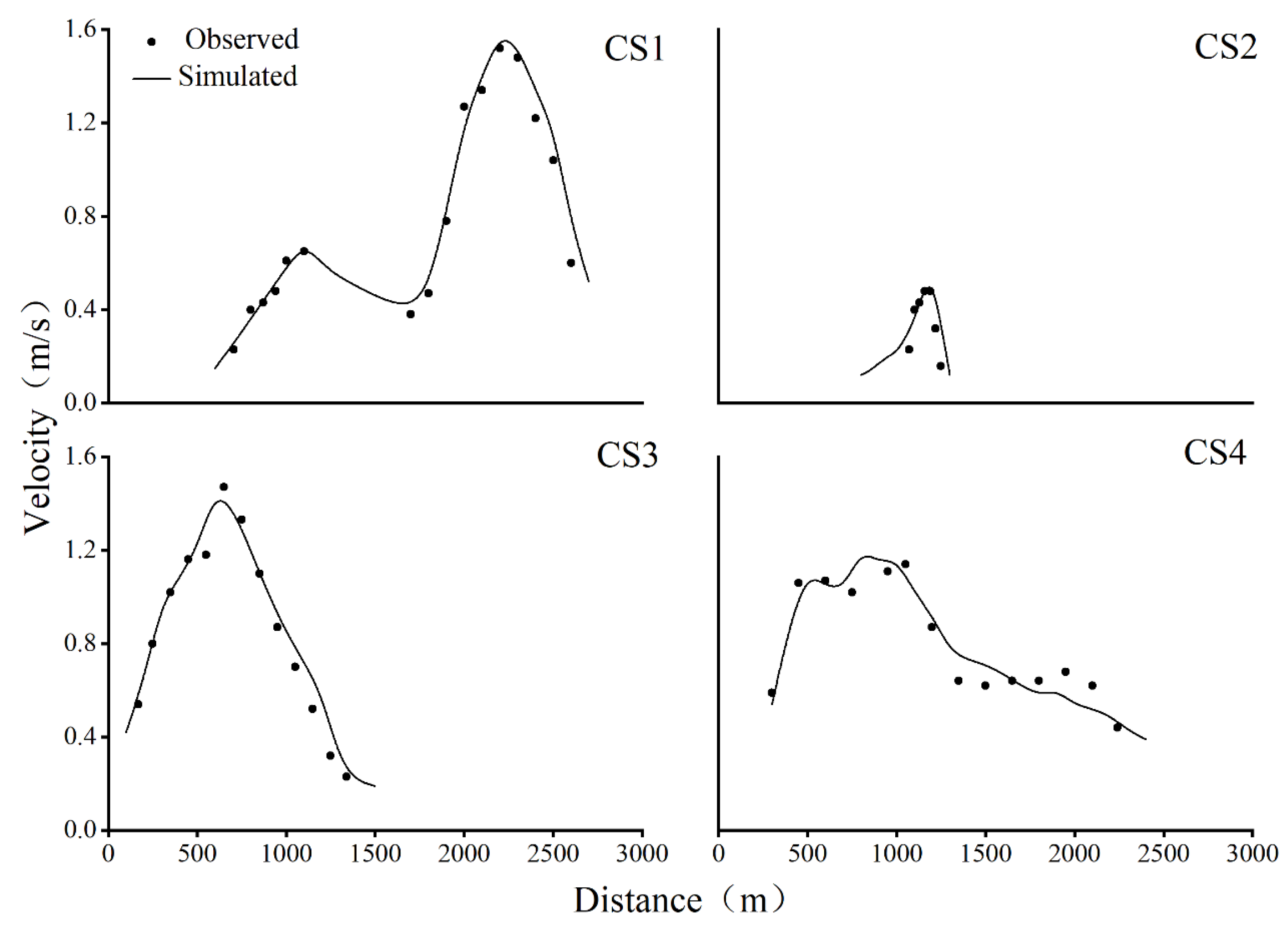

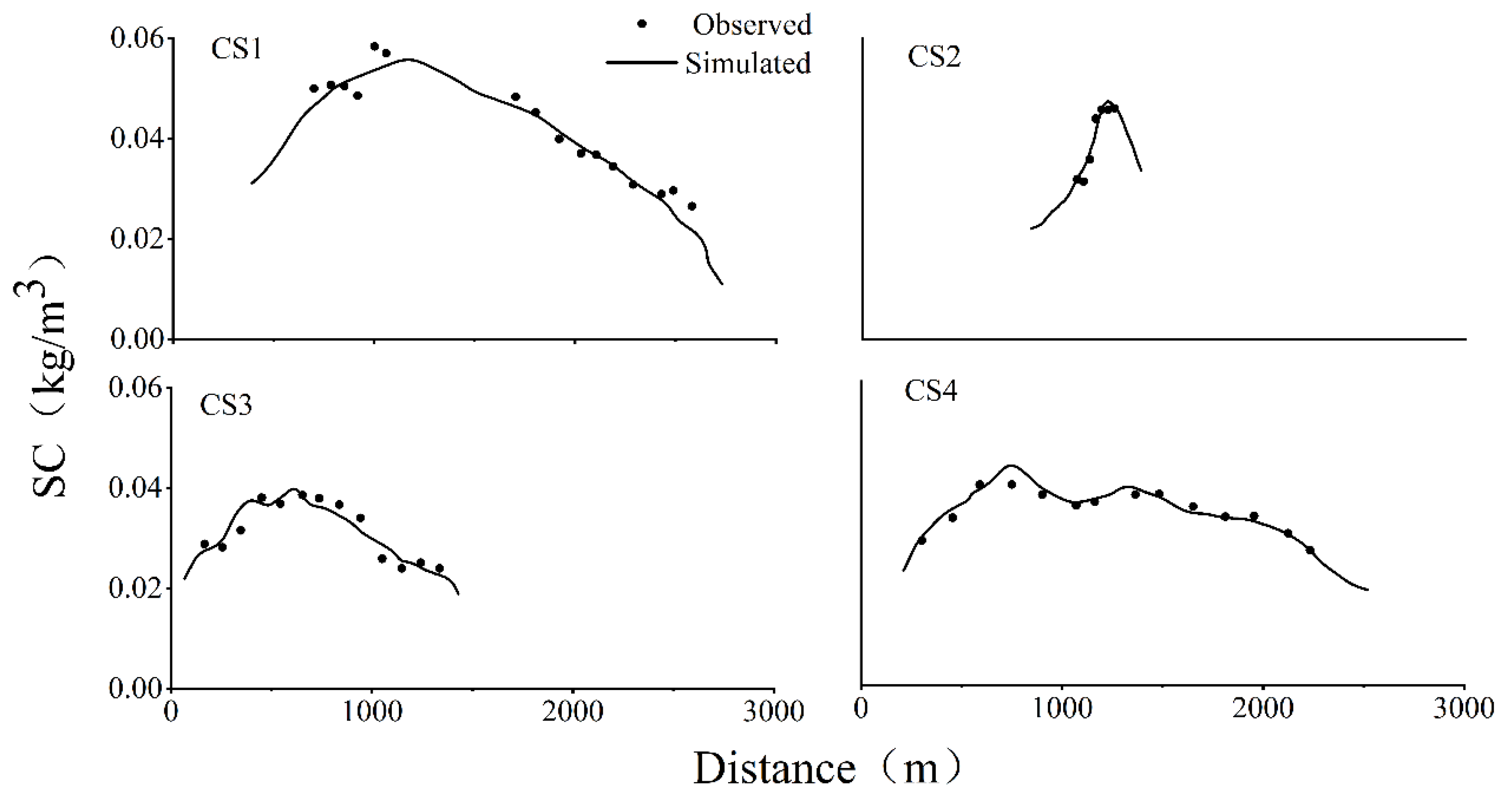

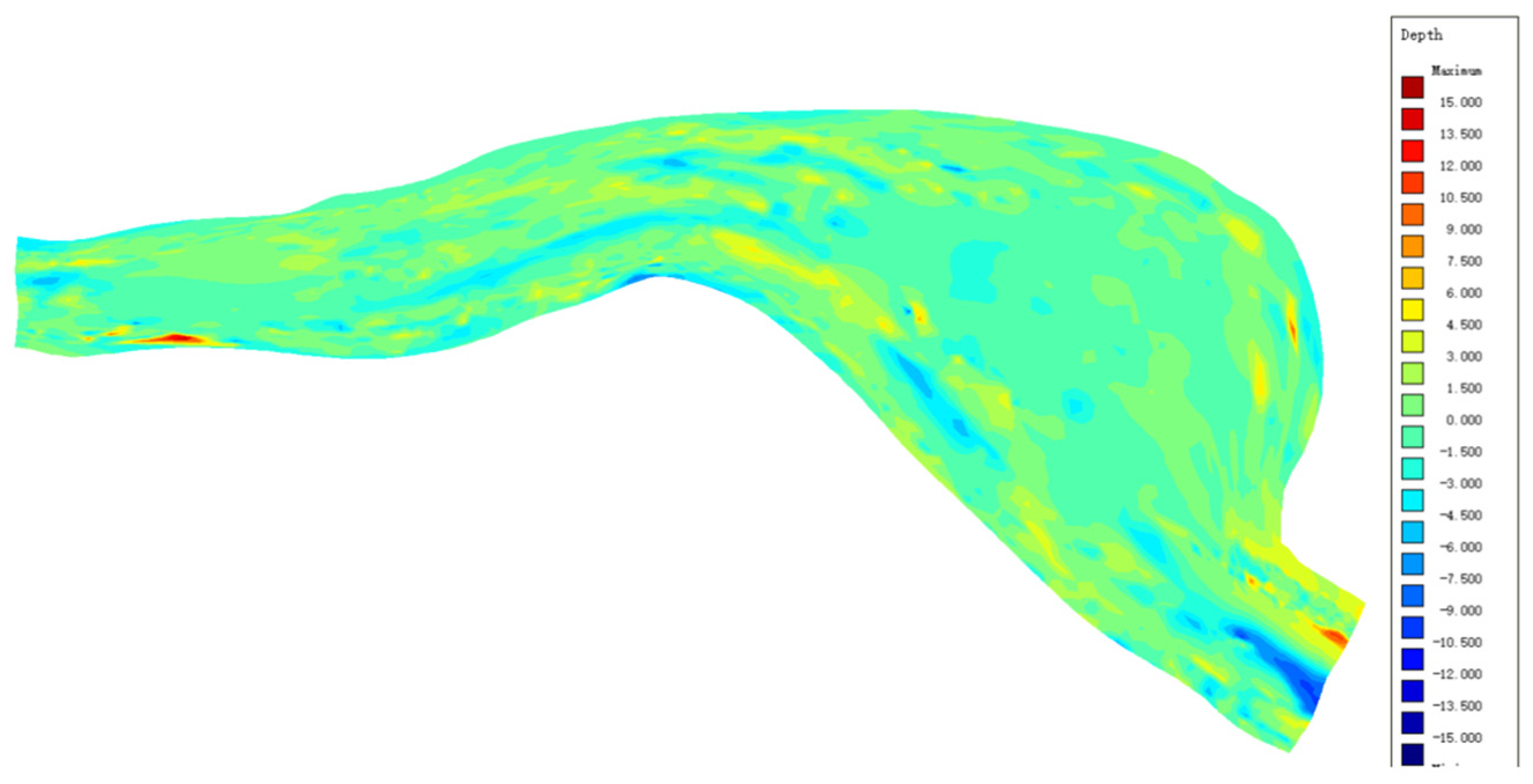
| With TGD | Without TGD | |||||
|---|---|---|---|---|---|---|
| Main Stream Flow (m3/s) | Tributary Flow (m3/s) | Flow Diversion Ratio | Main Stream Flow (m3/s) | Tributary Flow (m3/s) | Flow Diversion Ratio | |
| 3 March 2016 | 12,445 | 533 | 95.89% | 11,900 | 600 | 95.20% |
| 5 July 2018 | 26,634 | 2859 | 90.30% | 25,634 | 2458 | 91.25% |
| 4 March 2022 | 18,900 | 935 | 95.28% | 18,605 | 885 | 95.45% |
References
- Han, J.; Zhang, W.; Yuan, J.; Fan, Y. Channel evolution under changing hydrological regimes in anabranching reaches downstream of the Three Gorges Dam. Front. Earth Sci. 2018, 12, 640–648. [Google Scholar] [CrossRef]
- Kelin, H.; Ehab, M.; Andrew, N.J. The Effect of Phragmites australis Dieback on Channel Sedimentation in the Mississippi River Delta: A Conceptual Modeling Study. Water 2021, 13, 1407. [Google Scholar] [CrossRef]
- Huang, H.Q.; Wang, D.; Deng, C.; Liu, X.; Huang, L.; Ma, Y. Meandering-anabranching river channel change in response to flow-sediment regulation: Data analysis and model validation. J. Hydrol. 2019, 579, 124209. [Google Scholar]
- Li, L.; Ni, J.; Chang, F.; Yue, Y.; Frolova, N.; Magritsky, D.; Borthwick, A.G.L.; Ciais, P.; Wang, Y.; Zheng, C.; et al. Global trends in water and sediment fluxes of the world’s large rivers. Sci. Bull. 2020, 65, 62–69. [Google Scholar] [CrossRef]
- Zhu, L.; Yang, Y.; Zheng, J.; Zhang, H.; Wang, J. Influence of the Three Gorges Dam on the transport and sorting of coarse and fine sediments downstream of the dam. J. Hydrol. 2022, 615, 128654. [Google Scholar]
- Yang, H.; Jiao, X.; Guo, W.; Yu, L.; Huang, L.; Wang, H.; Wang, B. Synergistic evolution and attribution analysis of water-sediment in the middle and lower reaches of the Yangtze River. J. Hydrol. Reg. Stud. 2024, 51, 101626. [Google Scholar]
- Li, X.; Li, J.; Zhang, X.; Zhou, Y.; Zhang, Y. Enhanced lakebed sediment erosion in Dongting Lake induced by the operation of the Three Gorges Reservoir. J. Geogr. Sci. 2015, 25, 917–929. [Google Scholar]
- Liu, W.; Zhou, L.; Zhu, L.; Wang, J.; Yang, Y. Impact of upstream reservoirs on geomorphic evolution in the middle and lower reaches of the Yangtze River. Earth Surf. Proc. Land 2022, 48, 582–595. [Google Scholar]
- Zhang, D.; Dai, M.; Li, Y.; Wang, H. Characteristics of runoff in the three outlets along Jingjiang River and the influence of water supplement by the reservoirs during 1956–2020. J. Lake Sci. 2022, 34, 945–957. [Google Scholar]
- Richter, B.D.; Baumgartner, J.V.; Powell, J.; Braun, D.P. A Method for Assessing Hydrologic Alteration within Ecosystems. Conserv. Biol. 1996, 10, 1163–1174. [Google Scholar] [CrossRef]
- Ahmed, P.; Javaid, S.; Bhat, W.A.; Rather, A.F.; Ahmed, R.; Ahmad, S.T. Assessing changing flow regime of upper and middle reaches of Narmada river using the indicators of hydrological alterations (IHA) metrics. ISH J. Hydraul. Eng. 2023, 29 (Suppl. S1), 315–324. [Google Scholar]
- Deng, S.; Xia, J.; Zhou, M.; Lin, F. Variations in planform and cross-sectional geometries of the Jianli reach over the past fifty years. Chin. Sci. Bull. 2017, 62, 2698–2708. [Google Scholar]
- Wang, S.; Duan, G.; Tian, L.; Wang, M.; Shu, A.; Rubinato, M. An Experimental Study on Mechanisms for Sediment Transformation Due to Riverbank Collapse. Water 2019, 11, 529. [Google Scholar] [CrossRef]
- Wei, H.-Y.; Yu, M.-H.; Wu, S.-B. Experimental study on the bank erosion and interaction with near-bank bed evolution due to fluvial hydraulic force. Int. J. Sediment Res. 2015, 30, 81–89. [Google Scholar]
- Zhang, F.; Yuncheng, W.; Xiaojun, W. Study on hydrodynamic index threshold of early warning model for bank collapse in lower reaches of Yangtze River. J. Hydraul. Eng. ASCE 2023, 42, 53–64. [Google Scholar]
- Attari, M.; Hosseini, S.M. A simple innovative method for calibration of Manning’s roughness coefficient in rivers using a similarity concept. J. Hydrol. 2019, 575, 810–823. [Google Scholar] [CrossRef]
- Yan, B.; Chen, Y.; Li, J.; Yao, L.; Xu, B.; Chen, Q.; Zhang, X. Analysis of the influence of reservoir regulation on the multi-scale periodic effect of runoff time series. IOP Conf. Ser. Earth Environ. Sci. 2020, 560, 012042. [Google Scholar]
- Mei, X.; Wei, W.; Ge, Z.; Lou, Y.; Wang, J.; Dai, Z. Immediately downstream effects of Three Gorges Dam on channel sandbars morphodynamics between Yichang-Chenglingji Reach of the Changjiang River, China. Chin. Geogr. Sci. 2018, 28, 629–646. [Google Scholar]
- Deng, C.; Jiang, L.; Long, R.; Ge, H.; Zhu, L. Decadal Hydro-Morphodynamic Evolution of a Sandy Meander Bend Downstream of the Three Gorges Dam and Impact on Waterway Navigation. Water 2022, 14, 3126. [Google Scholar] [CrossRef]
- Mao, Y.; Deng, S.; Xia, J.; Zhou, M.; Xu, Q.; Liu, X. Contributions of different sources to sediment transport in the Middle Yangtze River under intensive channel degradation. Catena 2022, 217, 106511. [Google Scholar]
- Xie, B.; Tian, S.; Wang, W.; Zhang, M. Fluvial processes of the downstream reaches of the reservoirs in the Lower Yellow River. J. Geogr. Sci. 2016, 26, 1321–1336. [Google Scholar]
- Mosselman, E. Studies on River Training. Water 2020, 12, 3100. [Google Scholar] [CrossRef]
- Wang, Y.; Zhong, D.; Zhang, Y.J.; Li, X.; Wang, Y.; Zhang, H. Wide river or narrow river: Future river training strategy for Lower Yellow River under global change. Int. J. Sediment Res. 2018, 33, 271–284. [Google Scholar]
- Shahmohammadi, R.; Afzalimehr, H.; Sui, J. Assessment of Critical Shear Stress and Threshold Velocity in Shallow Flow with Sand Particles. Water 2021, 13, 994. [Google Scholar] [CrossRef]
- Sun, Z.; Yang, X.; Li, D.; Deng, J.; Li, Y. Relationship between the equilibrium morphology of river islands and flow-sediment dynamics based on the theory of minimum energy dissipation. Int. J. Sediment Res. 2022, 37, 514–521. [Google Scholar]
- Liu, H.; Lu, Y.; Wang, Z. Self-adjustment mechanism of bed structures under hydrology and sediment regimes. Hydrol. Res. 2016, 47, 136–148. [Google Scholar] [CrossRef]
- Li, Y.; Wang, B.; Liu, Y. Research on Applicability of Lower Yellow River Training Works after Beginning of Xiaolangdi Reservoir Operation. Procedia Eng. 2012, 28, 776–780. [Google Scholar]
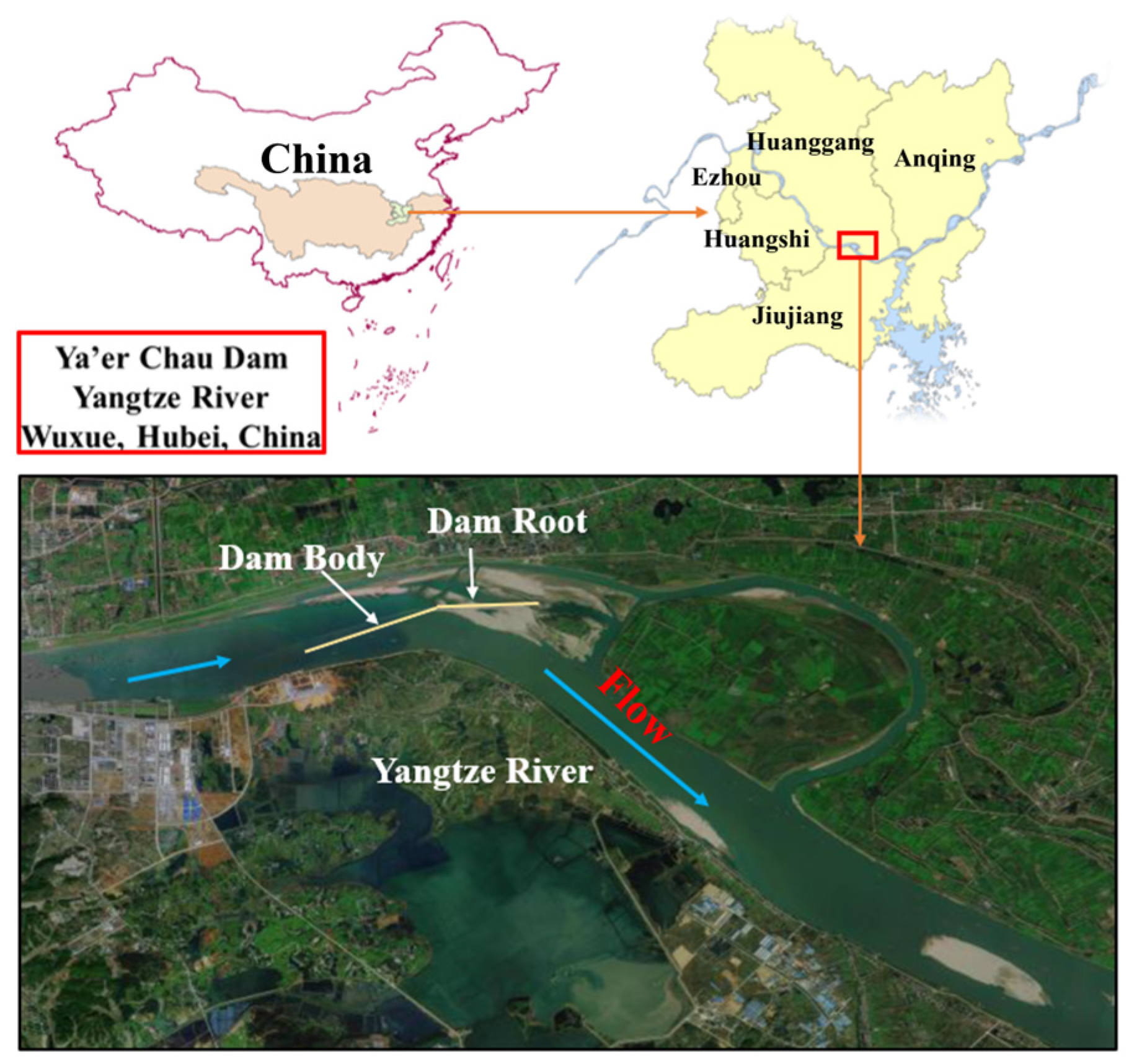
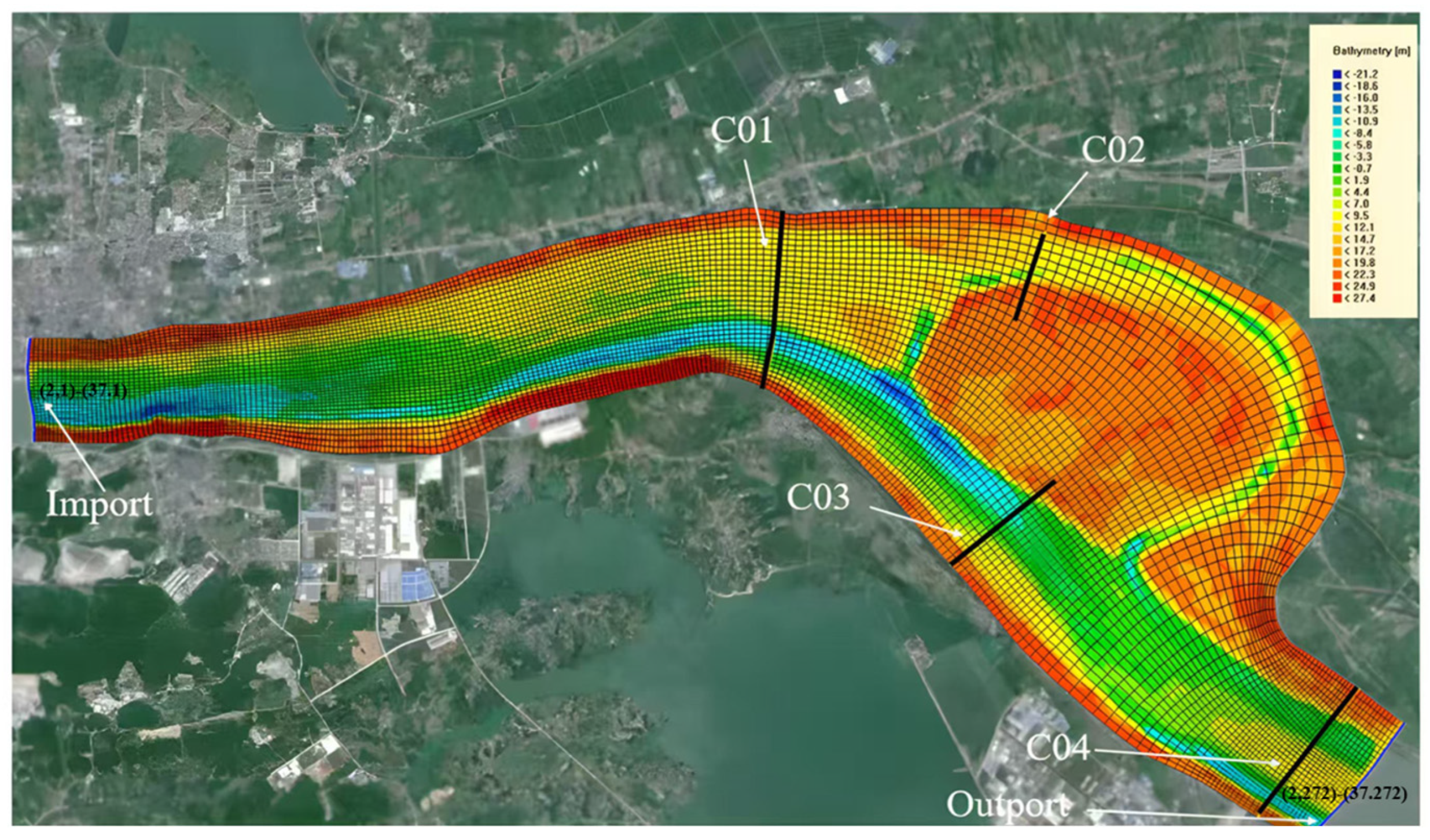
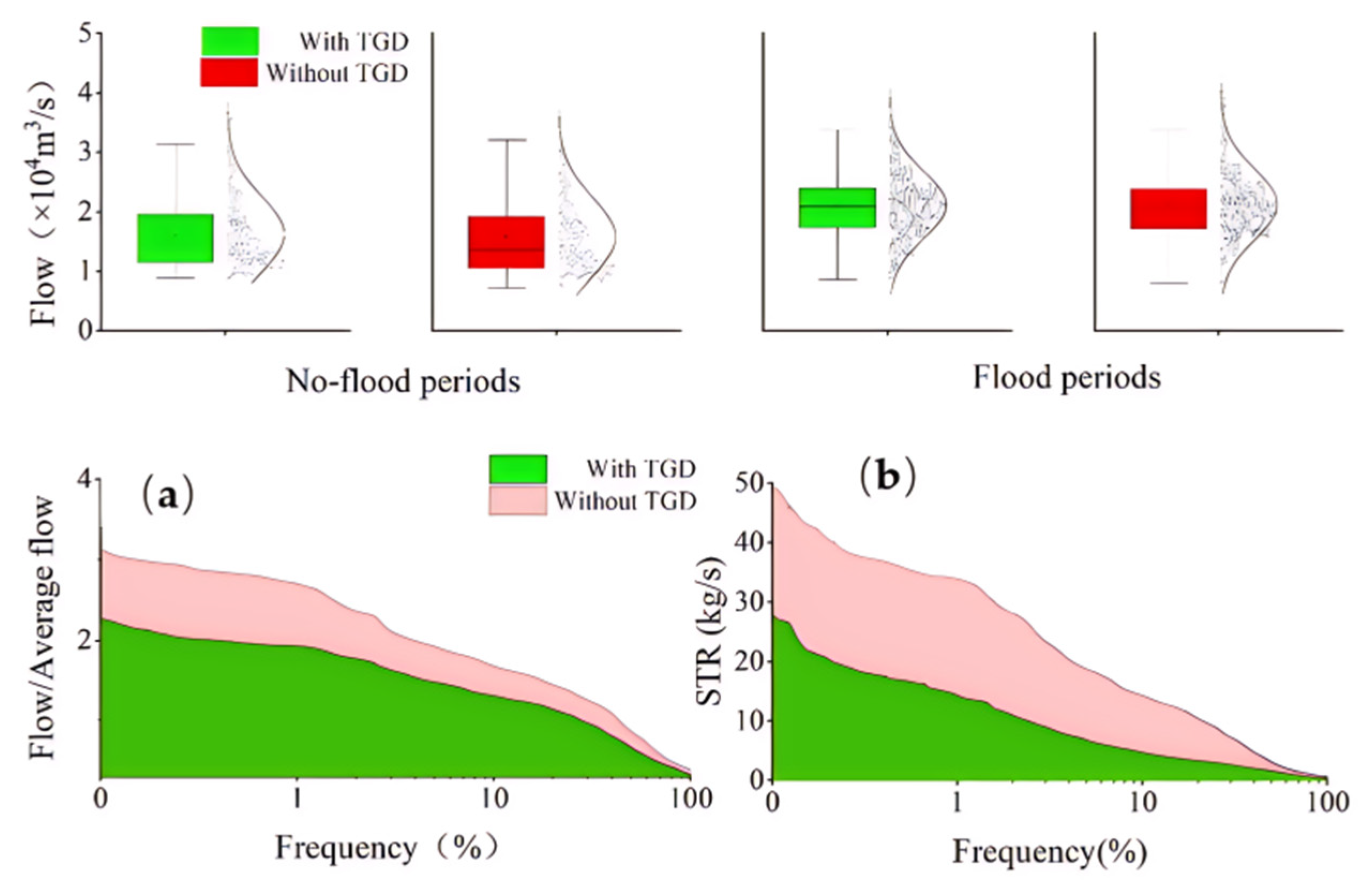
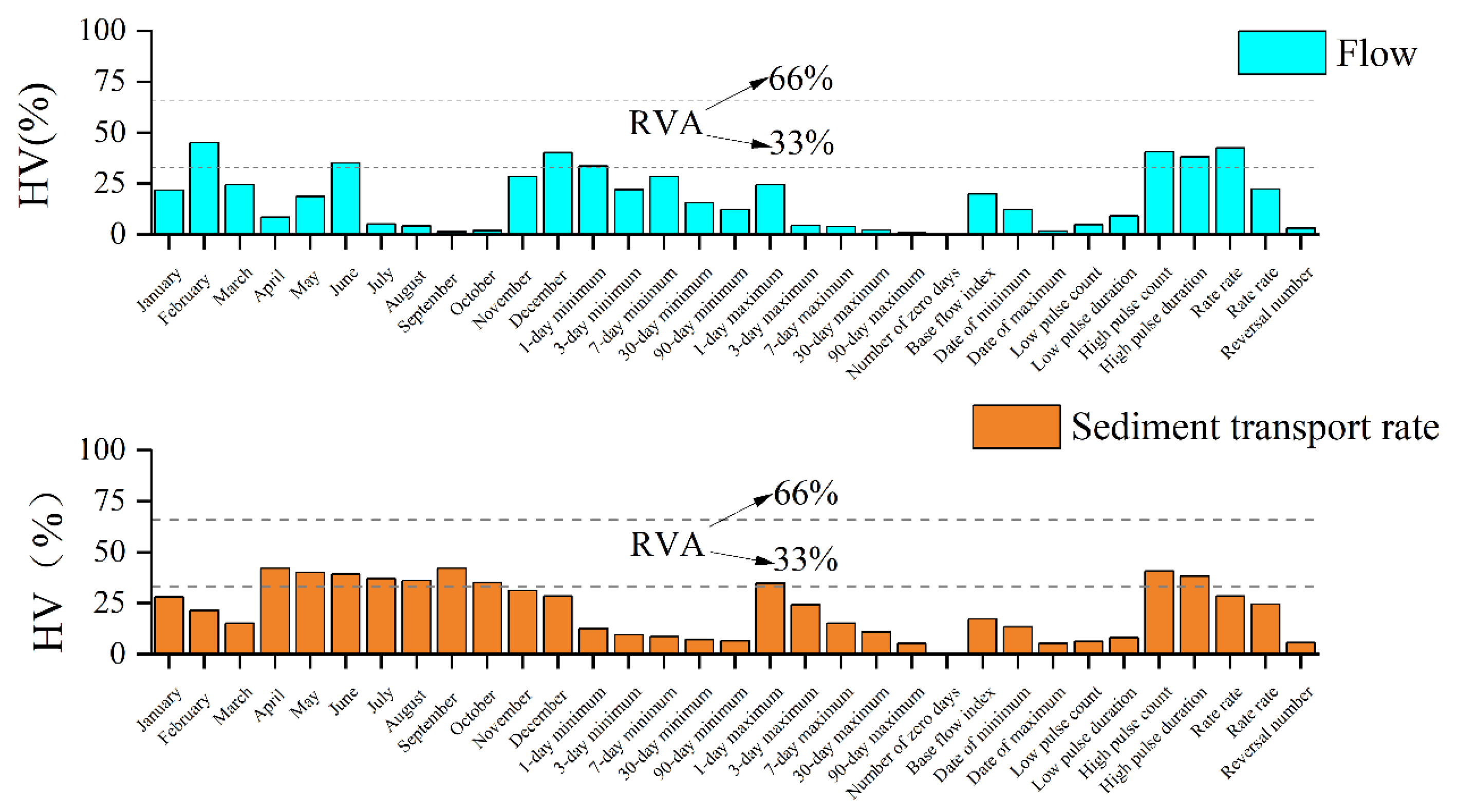
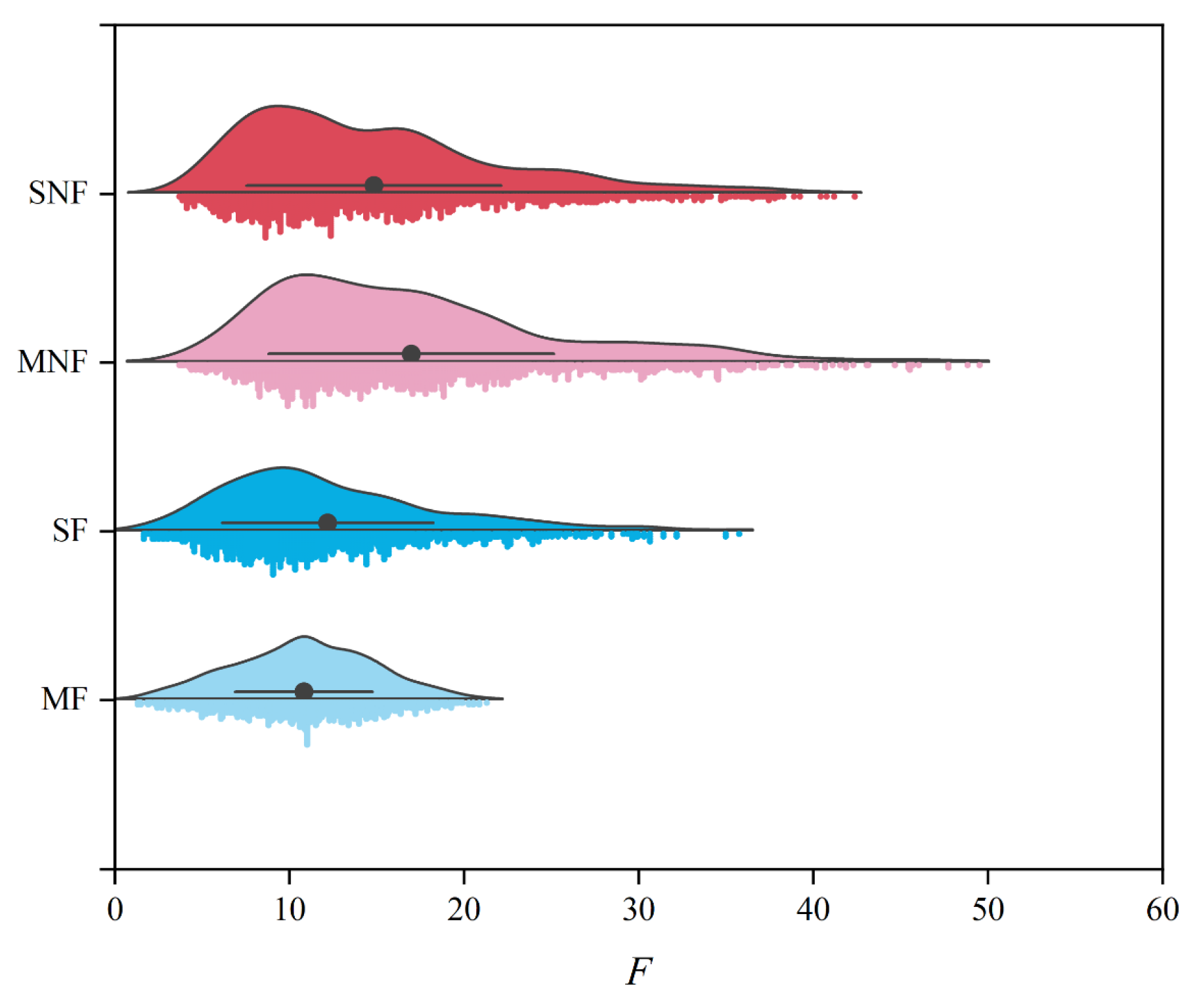
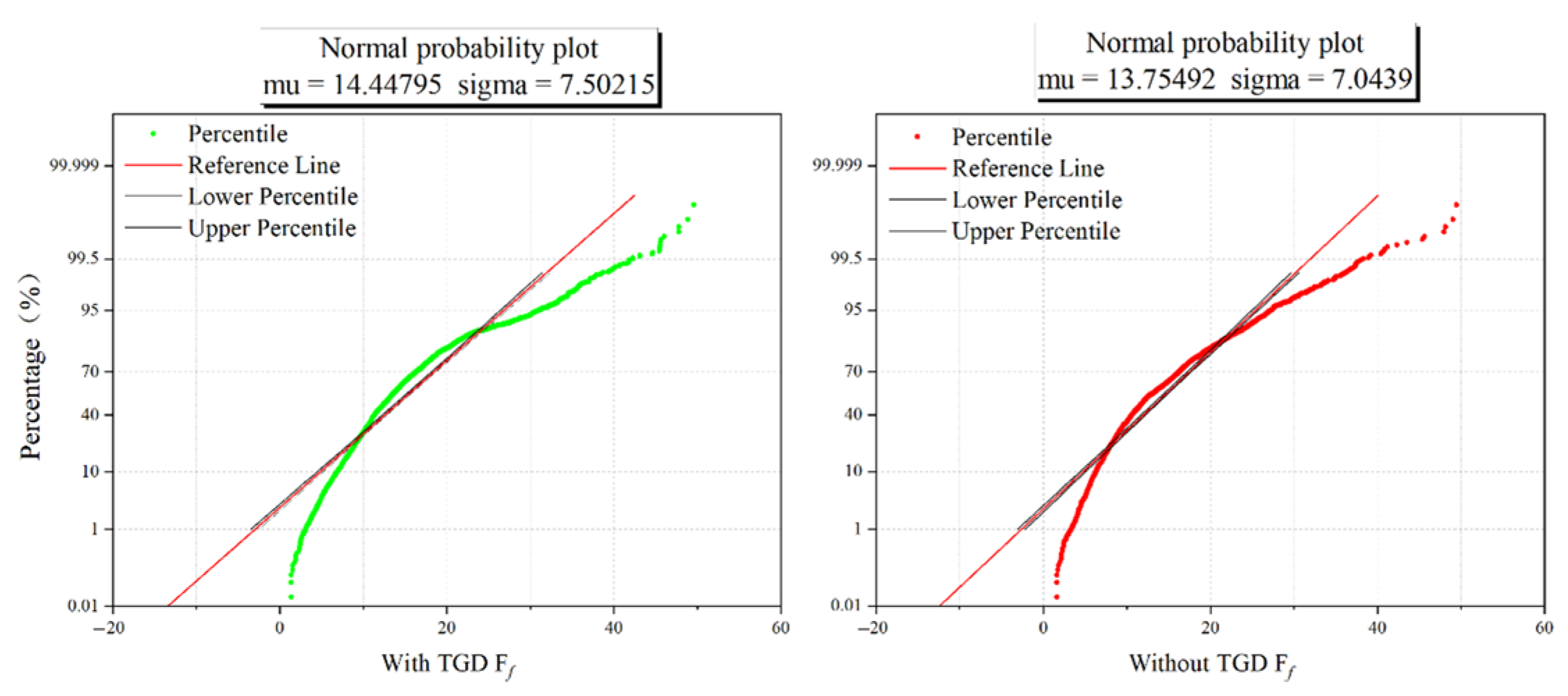
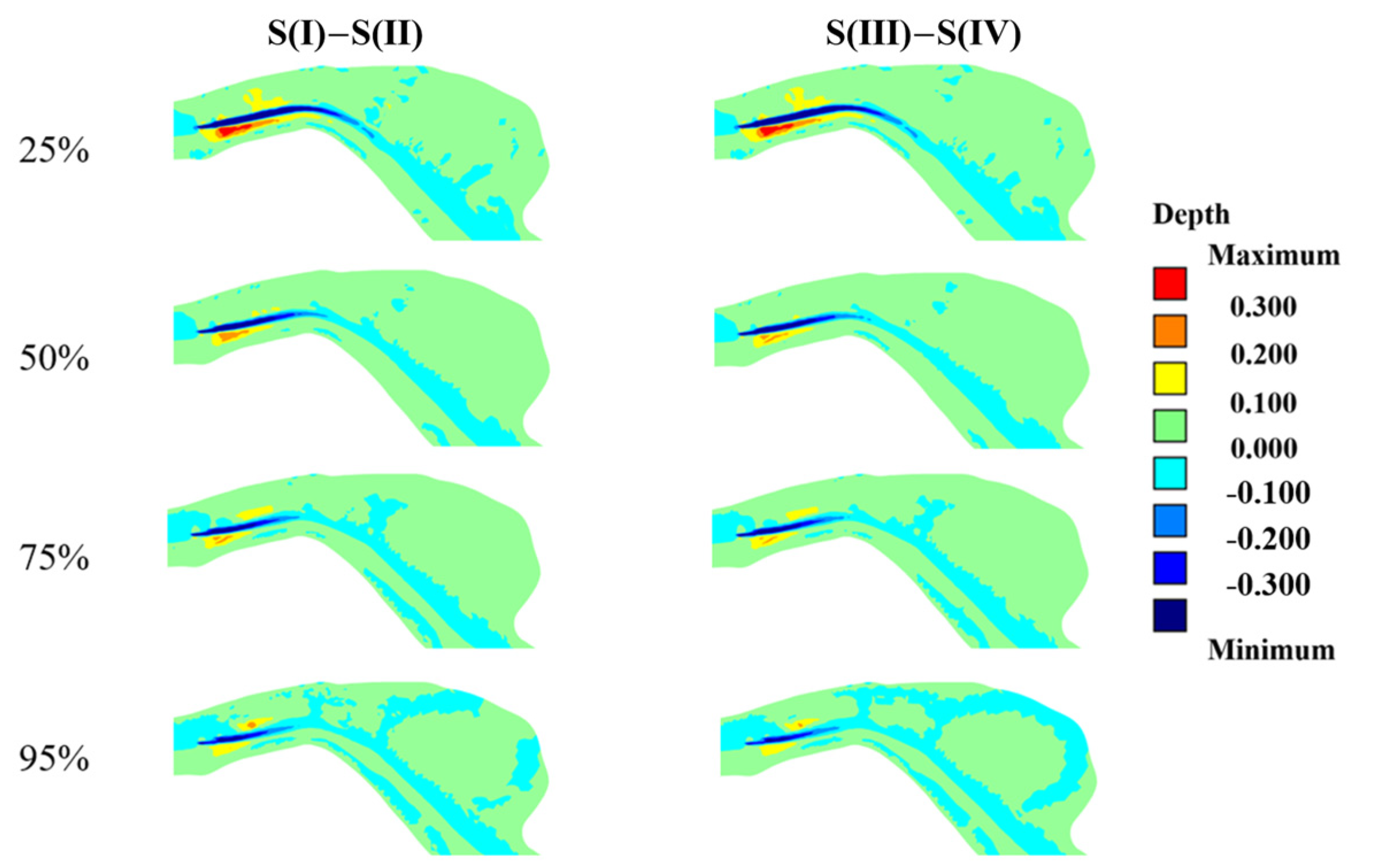

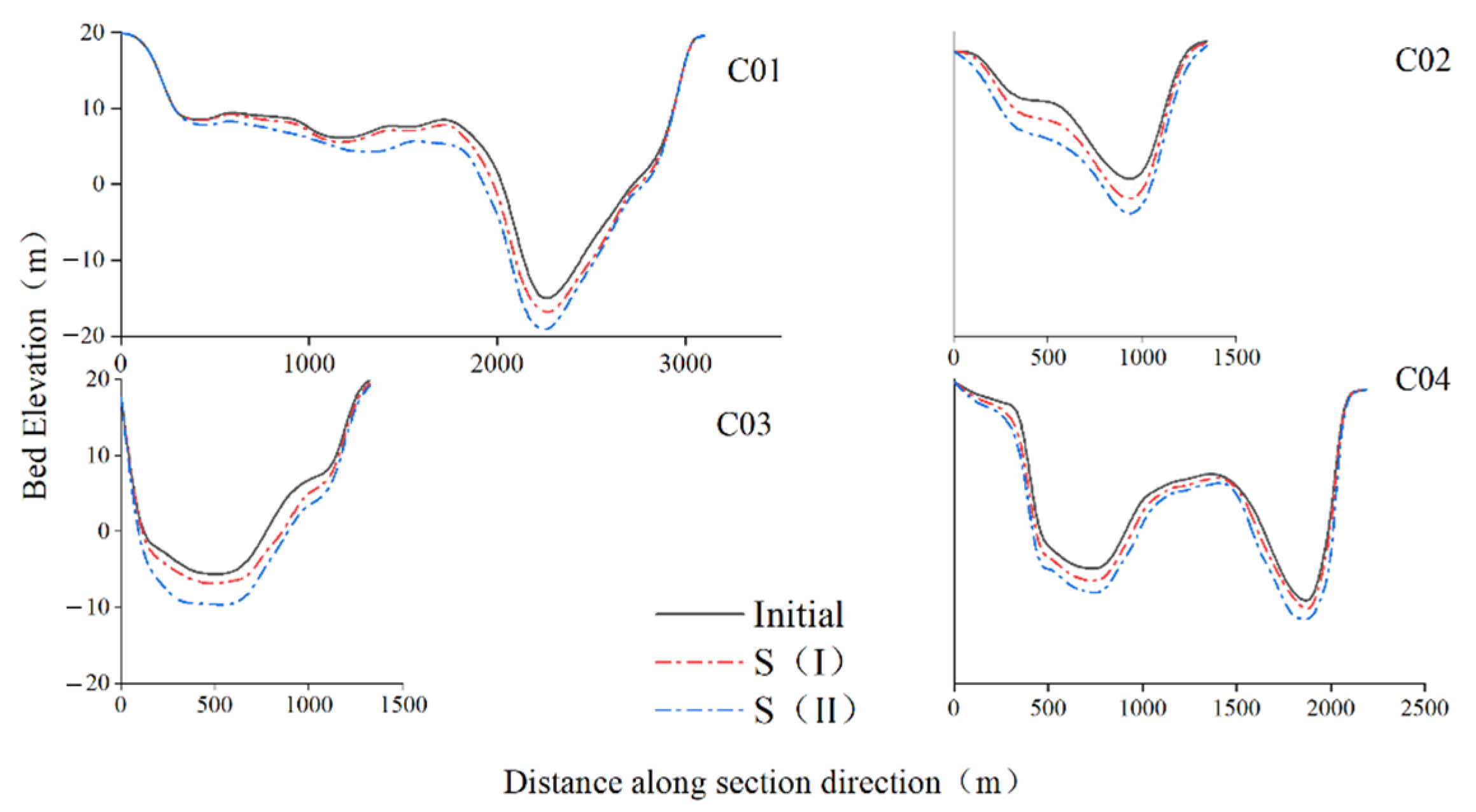
| Data Items | Time | Data Characteristics | Source |
|---|---|---|---|
| Riverbed topography (m) | 2018 | Hankou–Datong channels (map scale 1:10,000) | Hydrographic Bureau of the Yangtze River Water Resources Commission (YRWRC) Wuhan, Hubei Province, China |
| Sediment discharge (kg/m3) | 2003–2023 | Yichang, Shashi, Hankou, Jiujiang, and Datong hydrological stations | |
| Flow rate (m/s) | 2003–2023 | Hankou and Jiujiang hydrological stations | |
| Water level (m) | 2003–2023 | Hankou and Jiujiang hydrological stations |
| Groups | IHA Index System | Hydrological Characteristic Index |
|---|---|---|
| 1 | Monthly flow | Average flow over 12 months. Minimum annual flow (1 d, 3 d, 7 d, 30 d, 90 d) |
| 2 | Extreme hydrological conditions | Minimum annual flow (1 d, 3 d, 7 d, 30 d, 90 d) Base flow index |
| 3 | The time of occurrence of the annual peak flow | The timing of the annual maximum (minimum) flow |
| 4 | The frequency and duration of high and low flows | Number of high (low) pulses per year The duration of the high (low) pulse |
| 5 | The rate and frequency of flow changes | Number of process changes per year |
| Frequency | With TGD | Without TGD | ||||
|---|---|---|---|---|---|---|
| Upstream Inflow (m3/s) | Downstream Water Level (m) | Sediment Concentration (kg/m3) | Upstream Inflow (m3/s) | Downstream Water Level (m) | Sediment Concentration (kg/m3) | |
| 95% | 9802 | 8.94 | 0.072 | 9790 | 8.47 | 0.035 |
| 75% | 13,207 | 10.53 | 0.102 | 13,000 | 10.15 | 0.058 |
| 50% | 18,578 | 13.2 | 0.164 | 18,000 | 12.49 | 0.08 |
| 25% | 32,500 | 17.3 | 0.29 | 30,500 | 16.01 | 0.112 |
| Groups | With Training Projects | Without Training Projects | Flow Characteristics (m3/s) | Sediment Concentration (kg/m3) | ||
|---|---|---|---|---|---|---|
| With TGD | S(Ⅰ) | S(Ⅱ) | Average | 22,591 | Average | 0.100 |
| Maximum | 65,900 | Maximum | 1.050 | |||
| Minimum | 7920 | Minimum | 0.020 | |||
| Without TGD | S(Ⅲ) | S(Ⅳ) | Average | 22,457 | Average | 0.410 |
| Maximum | 69,414 | Maximum | 2.320 | |||
| Minimum | 7895 | Minimum | 0.019 | |||
Disclaimer/Publisher’s Note: The statements, opinions and data contained in all publications are solely those of the individual author(s) and contributor(s) and not of MDPI and/or the editor(s). MDPI and/or the editor(s) disclaim responsibility for any injury to people or property resulting from any ideas, methods, instructions or products referred to in the content. |
© 2025 by the authors. Licensee MDPI, Basel, Switzerland. This article is an open access article distributed under the terms and conditions of the Creative Commons Attribution (CC BY) license (https://creativecommons.org/licenses/by/4.0/).
Share and Cite
Yue, Y.; Huang, W.; Guo, Y.; Zhang, J.; Yang, Y.; Zhang, D.; Liu, L.; Chen, X. Effectiveness of River Training Projects in Controlling Shoal Erosion: A Case Study of the Middle Yangtze River. Hydrology 2025, 12, 148. https://doi.org/10.3390/hydrology12060148
Yue Y, Huang W, Guo Y, Zhang J, Yang Y, Zhang D, Liu L, Chen X. Effectiveness of River Training Projects in Controlling Shoal Erosion: A Case Study of the Middle Yangtze River. Hydrology. 2025; 12(6):148. https://doi.org/10.3390/hydrology12060148
Chicago/Turabian StyleYue, Yao, Weiya Huang, Yaxin Guo, Junhong Zhang, Yunping Yang, Dongdong Zhang, Linshuang Liu, and Xinxin Chen. 2025. "Effectiveness of River Training Projects in Controlling Shoal Erosion: A Case Study of the Middle Yangtze River" Hydrology 12, no. 6: 148. https://doi.org/10.3390/hydrology12060148
APA StyleYue, Y., Huang, W., Guo, Y., Zhang, J., Yang, Y., Zhang, D., Liu, L., & Chen, X. (2025). Effectiveness of River Training Projects in Controlling Shoal Erosion: A Case Study of the Middle Yangtze River. Hydrology, 12(6), 148. https://doi.org/10.3390/hydrology12060148






